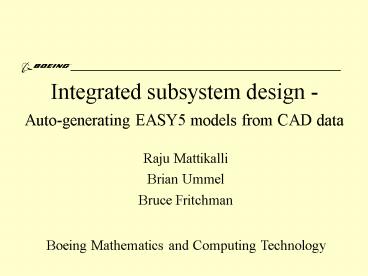Integrated subsystem design Autogenerating EASY5 models from CAD data PowerPoint PPT Presentation
1 / 25
Title: Integrated subsystem design Autogenerating EASY5 models from CAD data
1
Integrated subsystem design - Auto-generating
EASY5 models from CAD data
- Raju Mattikalli
- Brian Ummel
- Bruce Fritchman
Boeing Mathematics and Computing Technology
2
Overview
- Integrated design - information flow
- Subsystem design process today
- KIRTS
- KIRTS-EASY5 proof of concept
- Lessons learnt
- Conclusions, future work
3
Information flow during design
Preliminary Design
Detailed Design
Functional Analysis
- Gaps exists
- Tool integration is required
- Need to improve product representation
4
Integrated design
- Requirements -
- Manage change
- Maintain consistency
- Represent system in intermediate states
- Support different views
- Capture product variations
- Concurrent product/process development
5
Our context - System (tubing) design
6
The process today
- PD
- Architecture
- Functional requirements interfaces
- Schematic
- Analysis, get component requirements
- ID
- Schematic ltgt component catalog
- Analysis ltgt vendor software
- Refine analysis
7
The process today (contd.)
- DD
- Physical components for nodes
- Place components in 3D
- Determine interfaces
- Schematic lines to spaghetti tubes
- Route tubes
- Break tubes
- Finalize schematic, rerun simulation
8
The tools
- IDM - preliminary design
- architecture, layout, schematic, sizing
- EASY5 - functional analysis
- performance
- CATIA - corporate CAD, PDM tool
- KIRTS - detailed design
- generative geometry
- SPARTS, ESDS, CPIMS, Enovia
9
Filling the gaps
EASY5 - connectivity - flow direction -
parameters - analysis
IDM (PD) - connectivity - tube size, c-line -
flow reqds - flight condn
Schematic (KIRTS) - connectivity - logical
ports - EASY5 types - mapping to geom
KIRTS - geometry - assembly str
CATIA
10
Build a proof of concept
- Automatic EASY5 model from KIRTS
- Input to KIRTS
- equipment geometry
- equip. names, types
- connectivity
- KIRTS generates tubes
- Output from KIRTS
- EASY5 XML of schematics
- Functional model in EASY5
11
KIRTS Aircraft Systems Design
- In context design generation
- Rich design representations
- Find errors and inconsistencies
- Explore and evaluate design alternatives
12
KIRTS approach
- Rich, integrated design representations
- Logical reasoning about design representations
- Design rules that operate on the design
representations - Grammars for generating languages of designs
13
Integrating CAD and Function
- CAD Representation
- Solid Models
- Parts Assemblies
- Ports / Interfaces
- Part Classifications
- Schematics
- Connectivity
- System Hierarchy
- Simulation Models
14
KIRTS context
15
KIRTS Schematic
- Component names, types, ports
- Connectivity
- Currently specified in prolog
- connect_ schem(FilterU, 'Outlet', Line3U, '1')
- connect_schem(ReliefValveU, 'Inlet', Line3U, '2')
16
Relate schematic to geometry
- Many-many mapping
- Need to maintain consistency
- Change propagation
17
Implement connectivity
- Generate tubes automatically
- Map tubes to schematic
18
Generate EASY5 XML
- Produced from schematic
- Geometric parameters obtained from KIRTS
- Other attributes also represented in KIRTS
- Integrated representation
XML file read into EASY5 produces.
19
EASY5 Model
20
A typical EASY5 component (Pipe)
INPUT
OUTPUT
- Quantity
Quantity
Port
Port
Description
Units
Description
Units
1 1 2 2 2
Mass inlet Temp Pressure O. Pres. Rate Temp Hy.
dia. Length Roughness Heat Coeff. Heat
Coeff. Flux Int. heat Therm. M.
Kg/m C bar bar/sec C cm cm cm W/m2/C W/m2/C W/cm2
W J/C
Q W TF P PD TR PF TW SQW SSS QF REY FRC ...
Mass inlet Temp Pressure O. Pres. Rate Temp Hy.
dia. Length Roughness Heat Coeff. Heat
Coeff. Flux Int. heat Therm. M.
Kg/m C bar bar/sec C cm cm cm W/m2/C W/m2/C W/cm2
W J/C
2 2 2 1 1 1
W TF P PD TR DH LEN RFC HI HO EFX QIN MTW ...
21
Library data
- Need to develop interfaces to library data
- Company has a variety of standards libraries
- Need a single library standard
- Geometry, ports, analysis parameters,
compatibility, preferred standards, inventory - SPARTS, ISDS, PSDS, DMAPS, Enovia, ...
22
Advantages
- Greatly simplifies generation of EASY5 model
- connectivity
- parameters
- Better control over scope of analysis
- specific geometric contexts
- specific spatial context
- specific system
23
Lessons learned
- Schematic is unifying concept
- However granularity of schematic differs
- Initial challenges
- Management of ports---multiple semantics
- Schematic to geometry link
- Source of parameter values for analysis
24
Need better integration
- Want ---
- Simulation based design
- Numerically optimize design parameters
- Integrate with PD
- Produce better design early in design
process
25
Conclusion
- Significant benefits from CAD integration
- simplifies generation of EASY5 model
- control scope of analysis
- more simulation during design
- But...we need better, integrated representations
- Towards simulation based optimal system design

